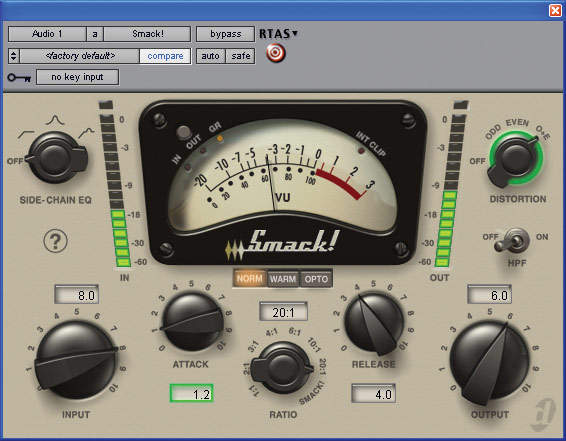 |
| A 'vintage' style software compressor |
Compression
Compression is an effect that can take a while to understand because the results are not always as obvious as other effects. To explain it as simply as possible, when a signal goes into a compressor, it gets turned down. That’s it. How it does this, how fast, and smoothly is what makes each one unique.Compressor Controls
Most compressors will have the same set of controls:The Threshold control sets what level will start the gain reduction.
The Ratio sets how much gain reduction, with a 4:1 ratio for every 4dB of signal above the threshold 1dB will be allowed through.
The Attack control sets how fast the compressor reacts to peaks.
The Release control sets how fast the compressor reacts as the signal lowers
Makeup gain is used to bring up the overall level of the compressor after the peaks have been reduced.
Sometimes there is an auto makeup gain control which will increase the output level to match the gain reduction.
Some compressors have a knee control that starts compressing at a lower ratio as the threshold is approached, this is very helpful for a more natural compression.
Compressors will usually have a few meters, an input level, gain reduction and output level. If there are only two meters there is usually a switch to change the output level to show gain reduction. Gain reduction meters go in the opposite direction of the level meters.
Setting a compressor
This is my method for setting a compressor:I choose a ratio depending on how aggressive I want the compression to be. The type of sound I’m using it on determines this, softer sounds like voice get lower ratios, bass gets a medium ratio and drums get a higher ratio.
I turn the attack and release controls to the fastest setting, and make sure the meter is showing gain reduction.
Then I lower the threshold level until I’m getting about 1 decibel of gain reduction on the peaks.
From there I’ll fine tune the attack and release for whatever sound most natural, and use the makeup gain to match the output with the input level.
If I want more compression, I’ll lower the threshold more.
- Example:
Here’s an example of some electric guitar with and without compression. I’m using more compression than I normally would on this so that the effect will be easier to hear. It should be pretty obvious that the compressor has evened out the dynamics of the performance.
[Listen to this example]
A slow attack will let some of the transient through, you can use this when you want to increase the punch of drums. You want to compress the sustain of the drum, and use the make up gain to make the drums larger than life.
- Example:
In this example there is an ambient room mic for a drumkit. First you will hear it without compression, then with (actually with a ton of compression), and I’ll increase (slow down) the attack time with each loop. Notice the increased bigness of the drums, and how the transients get through and keep it punchy.
[Listen to this example]
No comments:
Post a Comment